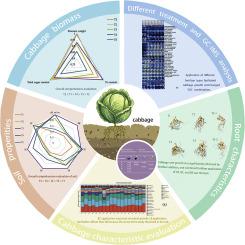Effects of organic and bacterial fertilizer application on cabbage characteristic and rhizosphere soil microorganisms
IF 6.8
Q1 PLANT SCIENCES
引用次数: 0
Abstract
The increasing demand for high quality fertilizer, which is being driven by human nutrition demand and agricultural soil protection, necessitates sustainable alternatives to be used as vegetable production. Thus, utilizing biochar (BC), bacterial fertilizer and their combination with organic fertilizer (OF) could be a sustainable approach. In our research work, OF, BC, liquid bacterial fertilizer (LB), and solid bacterial fertilizer (SB) were used to investigate different fertilizer combinations. Greenhouse field experiment was conducted to compare different fertilizer application and their effects on cabbage biomass, cabbage characteristics and soil physical and chemical properties. The results showed that combined application OF, BC, and LB promoted cabbage growth and resulted in the highest yield of 16.6 kg/m2. The vitamin C content was highest at 48.4 mg/kg with the combined application OF, BC, and SB treatment. The combined application OF, BC, and SB achieved the best overall comprehensive evaluation for cabbage biomass weight, vitamin C content, and total sugar content. The combined application OF and a bacterial fertilizer improved soil properties, while the addition of BC reduced the soil nutrient content. Gas chromatography-ion mobility spectrometry (GC-IMS) analysis showed that volatile organic compounds from cabbages were mainly esters, alcohols, acids, acetates, aldehydes, and ketones. These results provide a comprehensive understanding of different fertilizer applications and their effects on cabbage quality and rhizosphere soil.

有机肥和细菌肥对大白菜特性及根际土壤微生物的影响
在人类营养需求和农业土壤保护的驱动下,对优质肥料的需求不断增加,需要可持续的替代品用于蔬菜生产。因此,利用生物炭(BC)、细菌肥及其与有机肥(OF)相结合可能是一种可持续发展的途径。本研究采用OF、BC、液体细菌肥(LB)和固体细菌肥(SB)对不同的施肥组合进行了研究。通过大棚大田试验,比较了不同施肥方式对大白菜生物量、大白菜性状及土壤理化性状的影响。结果表明,施用有机肥、BC和LB可促进白菜生长,产量最高,达到16.6 kg/m2。有机肥、BC和SB复合处理的维生素C含量最高,为48.4 mg/kg。对白菜生物量、维生素C含量和总糖含量进行综合评价,有机肥、BC和SB配施效果最好。有机肥与细菌肥配施改善了土壤性质,而添加BC则降低了土壤养分含量。气相色谱-离子迁移谱(GC-IMS)分析表明,白菜中挥发性有机化合物主要为酯类、醇类、酸类、乙酸类、醛类和酮类。这些结果为全面了解不同肥料用量及其对白菜品质和根际土壤的影响提供了依据。
本文章由计算机程序翻译,如有差异,请以英文原文为准。
求助全文
约1分钟内获得全文
求助全文
来源期刊

Plant Stress
PLANT SCIENCES-
CiteScore
5.20
自引率
8.00%
发文量
76
审稿时长
63 days
期刊介绍:
The journal Plant Stress deals with plant (or other photoautotrophs, such as algae, cyanobacteria and lichens) responses to abiotic and biotic stress factors that can result in limited growth and productivity. Such responses can be analyzed and described at a physiological, biochemical and molecular level. Experimental approaches/technologies aiming to improve growth and productivity with a potential for downstream validation under stress conditions will also be considered. Both fundamental and applied research manuscripts are welcome, provided that clear mechanistic hypotheses are made and descriptive approaches are avoided. In addition, high-quality review articles will also be considered, provided they follow a critical approach and stimulate thought for future research avenues.
Plant Stress welcomes high-quality manuscripts related (but not limited) to interactions between plants and:
Lack of water (drought) and excess (flooding),
Salinity stress,
Elevated temperature and/or low temperature (chilling and freezing),
Hypoxia and/or anoxia,
Mineral nutrient excess and/or deficiency,
Heavy metals and/or metalloids,
Plant priming (chemical, biological, physiological, nanomaterial, biostimulant) approaches for improved stress protection,
Viral, phytoplasma, bacterial and fungal plant-pathogen interactions.
The journal welcomes basic and applied research articles, as well as review articles and short communications. All submitted manuscripts will be subject to a thorough peer-reviewing process.
 求助内容:
求助内容: 应助结果提醒方式:
应助结果提醒方式:


